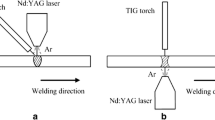Abstract
This study, based on the Simufact Welding analysis software, established a three-dimensional finite element computational model according to actual welding conditions. Using a combined volumetric heat source, we analyzed the magnitude and distribution of residual stress after laser arc composite welding of dissimilar aluminum alloys, and validated the results with experimental data. The influence of different preheating temperatures on the variation rule of residual stress in each part of the weldment was explored. The results showed that the calibration results of the combined volumetric heat source model were ideal, and that the simulation results of transverse and longitudinal residual stress were in good agreement with the actual results. The average residual stress in the heat-affected zone (HAZ) of the 5083-H112 aluminum alloy was about 190 MPa, which is close to the yield strength of the base metal at room temperature (193 MPa); the average residual stress at the weld seam was about 230 MPa; and the average residual stress in the HAZ of the 6063-T6 aluminum alloy was about 80 MPa. In addition, preheating before welding has a positive effect on reducing residual stress after welding. The optimal preheating temperature for the 5083-H112 aluminum alloy is about 170°C, and for 6063-T6 aluminum alloy it is about 220°C.








Similar content being viewed by others
References
Z.G. He, D.W. Zhou, A. Liu, S.W. Zhou, X.Y. Du, X.Y. Wang, and J.S. Liu, Opt. Laser Technol. 164, 109470 https://doi.org/10.1016/j.optlastec.2023.109470 (2023).
L. Wan, and Y.X. Huang, Int. J. Adv. Manuf. Technol. 99, 1781 https://doi.org/10.1007/s00170-018-2601-x (2018).
S.B. Yang, L. Yang, D.X. Wang, F.L. Zhang, C.J. Liu, and G.Z. Huang, Optik 271, 170165 https://doi.org/10.1016/j.ijleo.2022.170165 (2022).
S.B. Yang, D.X. Wang, L. Yang, F.L. Zhang, C. Zhang, B. Zhou, C.J. Liu, and G.Z. Huang, Optik 268, 169795 https://doi.org/10.1016/j.ijleo.2022.169795 (2022).
F. Hayat, Eng. Sci. Technol. 34, 101093 https://doi.org/10.1016/j.jestch.2022.101093 (2022).
S.B.A. Zhong, S. Han, J.Q. Chen, J.K. Ren, Z.X. Zhou, F. Wen, L. Qi, and R.G. Guan, Mater. Today Commun. 31, 103260 https://doi.org/10.1016/j.mtcomm.2022.103260 (2022).
J.M. Sun, and K. Dilger, J. Manuf. Process. 101, 259 https://doi.org/10.1016/j.jmapro.2023.06.011 (2023).
H. Xia, J.B. Wu, Z.Y. Xu, Z.T. Liu, X.F. Pan, B. Wang, J. Wang, and Z. Wang, Nondestruct. Test. Eval. 38, 701 https://doi.org/10.1080/10589759.2022.2159028 (2023).
W.T. Song, C.G. Xu, Q.X. Pan, and J.F. Song, Chin. J. Mech. Eng. 29, 365 https://doi.org/10.3901/cjme.2015.1023.126 (2016).
A. Chiocca, F. Frendo, F. Aiello, and L. Bertini, Int. J. Fatigue 162, 106901 https://doi.org/10.1016/j.ijfatigue.2022.106901 (2022).
G.L. Fan, C.F. Xue, O.O. Ojo, D. Bokov, S. Mehrez, M. Paidar, and J. Xu, Vacuum 196, 110712 https://doi.org/10.1016/j.vacuum.2021.110712 (2022).
D.Q. Sun, Y.Y. Zhang, Y.J. Liu, X.Y. Gu, and H.M. Li, Mater. Des. 109, 596 https://doi.org/10.1016/j.matdes.2016.07.076 (2016).
S.W. Cui, Y.H. Yu, R. Ma, F.Y. Tian, and S.W. Pang, Materials 16, 4886 https://doi.org/10.3390/ma16134886 (2023).
Y.Y. Guo, H.H. Pan, L.B. Ren, and G.F. Quan, Int. J. Adv. Manuf. Technol. 98, 1433 https://doi.org/10.1007/s00170-018-2206-4 (2018).
P. Wei, M.F. Wu, D.S. Liu, Z.Q. Zhao, Y. Liang, and Z.H. Dong, Materials 15, 3737 https://doi.org/10.3390/ma15103737 (2022).
U. Prisco, Weld. World 65, 2105 https://doi.org/10.1007/s40194-021-01167-3 (2021).
N. Yadaiah, and S. Bag, Int. J. Therm. Sci. 86, 125 https://doi.org/10.1016/j.ijthermalsci.2014.06.032 (2014).
M. Jafarzadegan, R. Taghiabadi, and M.A. Mofid, Mater. Today Commun. 31, 103411 https://doi.org/10.1016/j.mtcomm.2022.103411 (2022).
J. Goldak, A.P. Chakravarti, and M. Bibby, Mater. Metall. Mater. Trans. B 15, 299 https://doi.org/10.1007/BF02667333 (1984).
B.L. Dong, X.Y. Cai, S.B. Lin, Z.D. Ni, and C.L. Fan, Int. J. Adv. Manuf. Technol. 114, 2229 https://doi.org/10.1007/s00170-021-06928-4 (2021).
H.B. Cui, Y. Lu, C.X. Wang, X. Tang, Z.G. Liu, and R.D.K. Misra, Mater. Sci. Eng. A-Struct. Mater. Prop. Microstruct. Process. 836, 142697 https://doi.org/10.1016/j.msea.2022.142697 (2022).
W.H. Wang, W.H. Lin, R. Yang, Y.N. Wu, J.P. Li, Z.B. Zhang, and Z.R. Zhai, Mater. Des. 213, 110355 https://doi.org/10.1016/j.matdes.2021.110355 (2022).
X.Y. Gui, X.D. Gao, Y.X. Zhang, and J.K. Wu, Mod. Phys. Lett. B 36, 2150467 https://doi.org/10.1142/S0217984921504674 (2022).
B. Cui, S.Y. Liu, F.L. Zhang, T.W. Luo, and M. Feng, Int. J. Adv. Manuf. Tech. 119, 421 https://doi.org/10.1007/s00170-021-08113-z (2021).
Acknowledgements
The author (Dr. Chen) thanks the National Natural Science Foundation of China (No 51774249) and the State Key Laboratory of Oil and Gas Reservoir Geology and Exploitation (Southwest Petroleum University) for the Open Fund (PLN2021-22) and the Sichuan Provincial Engineering Research Center for Advanced Materials Preparation Technology for Shale Gas Efficient Exploitation Fund (No 2022SCYYQKCCL012) to conduct this research investigation.
Author information
Authors and Affiliations
Corresponding author
Ethics declarations
Conflict of interest
The authors declare that they have no conflict of interest.
Additional information
Publisher's Note
Springer Nature remains neutral with regard to jurisdictional claims in published maps and institutional affiliations.
Rights and permissions
Springer Nature or its licensor (e.g. a society or other partner) holds exclusive rights to this article under a publishing agreement with the author(s) or other rightsholder(s); author self-archiving of the accepted manuscript version of this article is solely governed by the terms of such publishing agreement and applicable law.
About this article
Cite this article
Chen, X., Tang, S., Xie, W. et al. Study on the Effect of Preheating Temperature on Residual Stress in Laser Arc Composite Welding of Dissimilar Aluminum Alloys. JOM (2024). https://doi.org/10.1007/s11837-024-06600-8
Received:
Accepted:
Published:
DOI: https://doi.org/10.1007/s11837-024-06600-8




